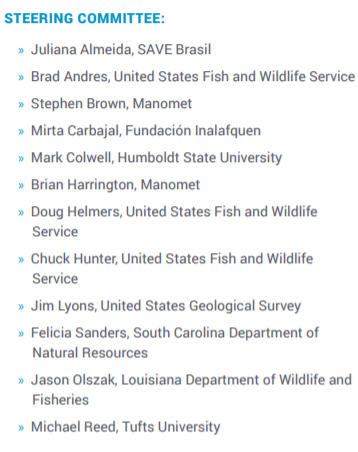Manomet is pleased to announce the completion of a new Shorebird Management Manual. This resource provides technical support to those with the ability to influence or implement beneficial habitat management decisions that can help stabilize declining populations of shorebirds in the Americas.
Manomet developed this new Shorebird Management Manual (Iglecia and Winn, 2021) with guidance from a Steering Committee of shorebird experts, contributing authors, and the cumulative work of hundreds of conservation scientists, ornithologists, and land managers.
“In 1992, Manomet published the first Shorebird Management Manual, by Doug Helmers,” said Brad Winn, Director of Shorebird Habitat Management. “Our collective understanding of these amazing birds has evolved considerably since then, and we knew several years ago that it was time to create another resource for today’s conservation practitioners. With Monica Iglecia’s* hard work and dedication, combined with significant contributions from many other experts, we have compiled this overview of management approaches and shorebird ecology to help inspire and guide beneficial habitat improvements everywhere these birds go.”
 “As we have developed flyway-scale conservation frameworks for shorebirds, a common theme is the continued education and outreach to land managers on the when, how, and where to improve and expand habitats for shorebirds. The revised manual provides a great resource for habitat managers,” adds Steering Committee member Brad Andres, National Coordinator, U.S. Shorebird Conservation Partnership, U.S. Fish and Wildlife Service.
“As we have developed flyway-scale conservation frameworks for shorebirds, a common theme is the continued education and outreach to land managers on the when, how, and where to improve and expand habitats for shorebirds. The revised manual provides a great resource for habitat managers,” adds Steering Committee member Brad Andres, National Coordinator, U.S. Shorebird Conservation Partnership, U.S. Fish and Wildlife Service.
This manual includes thirteen case studies in habitat management from across North, Central, and South America. These real-world scenarios, written by field experts, focus on strategies to improve shorebird productivity and survival within the Americas, south of the Arctic. Each case study includes:
- information on the species benefitted;
- the threats at the site;
- the actions taken to protect shorebirds at the site; and,
- outcomes and advice.
The Shorebird Management Manual is the core curriculum for Manomet’s Habitats for Shorebirds workshops. It also serves as a stand-alone resource to help guide habitat improvements that benefit shorebirds at the flyway, national, regional, and local planning levels. This manual’s key objective is that it can help site managers recognize local habitat values, understand the stressors or threats to the birds dependent on those habitats, and identify applicable management approaches to alleviate those challenges to survival.
“The destruction and degradation of wetlands, grasslands, and coastlines throughout the Americas over the last century have been a leading factor in the decline and imperilment of shorebird populations. We wrote this manual to help reverse the negative impacts of these depleted vital conditions,” adds Winn. “Shorebirds need our collective help, at all spatial scales, and working together we can all increase carrying capacity of important habitat, site by site, throughout the full migration paths of these birds.”
Plans are underway to translate the manual into Spanish and to make the manual available in print. To download the Shorebird Management Manual, click here: https://www.manomet.org/wp-content/uploads/2021/01/Iglecia_and_Winn_2021_AShorebirdManagementManual-012021-web.pdf.





 Back to all
Back to all